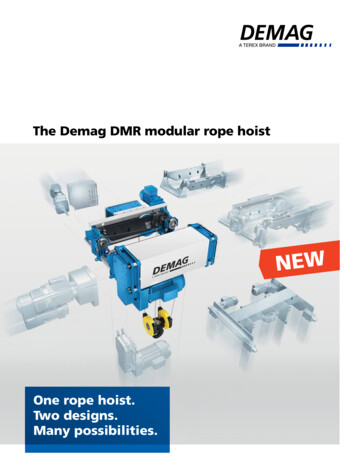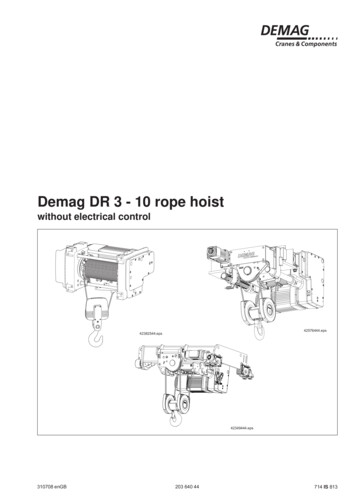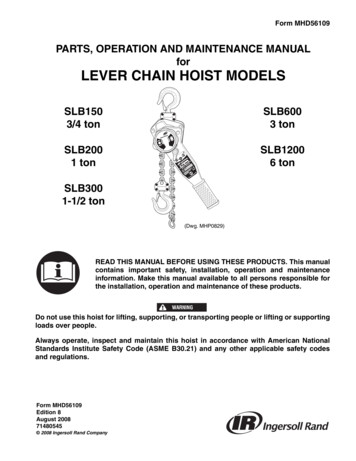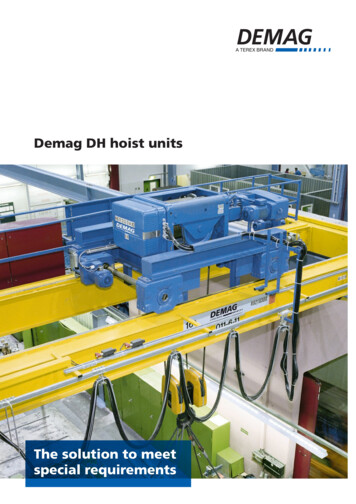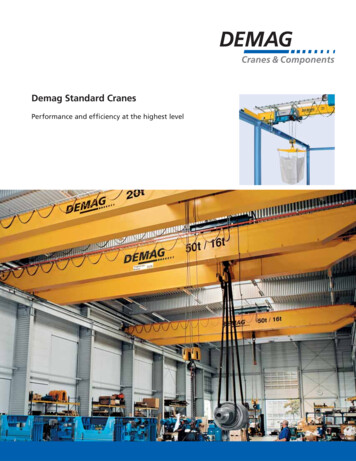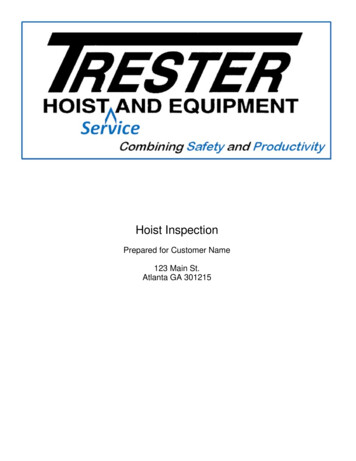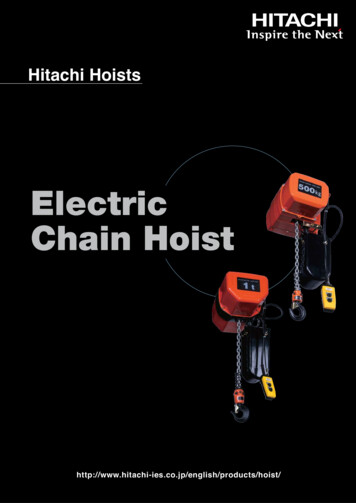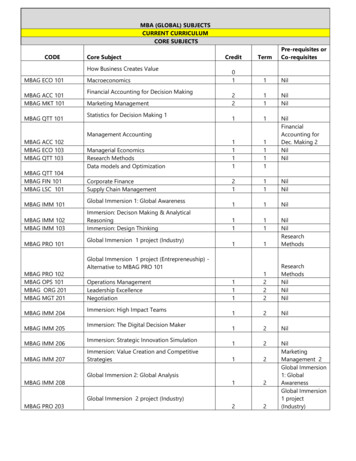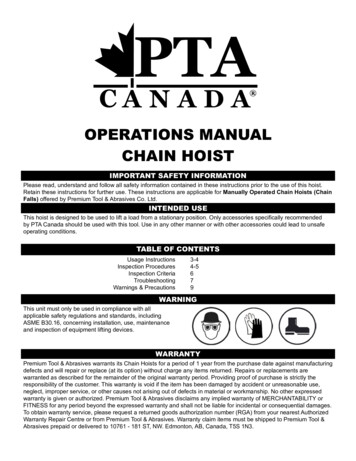
Transcription
OPERATIONS MANUALCHAIN HOISTIMPORTANT SAFETY INFORMATIONPlease read, understand and follow all safety information contained in these instructions prior to the use of this hoist.Retain these instructions for further use. These instructions are applicable for Manually Operated Chain Hoists (ChainFalls) offered by Premium Tool & Abrasives Co. Ltd.INTENDED USEThis hoist is designed to be used to lift a load from a stationary position. Only accessories specifically recommendedby PTA Canada should be used with this tool. Use in any other manner or with other accessories could lead to unsafeoperating conditions.TABLE OF CONTENTSUsage InstructionsInspection ProceduresInspection CriteriaTroubleshootingWarnings & Precautions3-44-5679WARNINGThis unit must only be used in compliance with allapplicable safety regulations and standards, includingASME B30.16, concerning installation, use, maintenanceand inspection of equipment lifting devices.WARRANTYPremium Tool & Abrasives warrants its Chain Hoists for a period of 1 year from the purchase date against manufacturingdefects and will repair or replace (at its option) without charge any items returned. Repairs or replacements arewarranted as described for the remainder of the original warranty period. Providing proof of purchase is strictly theresponsibility of the customer. This warranty is void if the item has been damaged by accident or unreasonable use,neglect, improper service, or other causes not arising out of defects in material or workmanship. No other expressedwarranty is given or authorized. Premium Tool & Abrasives disclaims any implied warranty of MERCHANTABILITY orFITNESS for any period beyond the expressed warranty and shall not be liable for incidental or consequential damages.To obtain warranty service, please request a returned goods authorization number (RGA) from your nearest AuthorizedWarranty Repair Centre or from Premium Tool & Abrasives. Warranty claim items must be shipped to Premium Tool &Abrasives prepaid or delivered to 10761 - 181 ST, NW. Edmonton, AB, Canada, T5S 1N3.
IMPORTANT SAFETY INSTRUCTIONS Read, understand and follow the safety information contained in these instructions prior to using this tool. Keep theseinstructions for further reference. Always operate, inspect and maintain this hoist in accordance with American National Standards Institute Safety CodeASME B30.16 and any other applicable safety codes and regulations. Hoists are designed to provide a 4 to 1 safety factor. Supporting structures and load-attaching devices used inconjunction with this hoist must provide an adequate safety factor to handle the rated load, plus the weight of the hoistand attached equipment. This is the customer’s responsibility. Rigging: it is the responsibility of the operator to exercise caution and be familiar with proper rigging techniques. Referto ASME B30.9 for rigging information. Do not exceed rated capacity. Hooks are designed to bend or stretch when overloading is detected. Do not use this hoist for lifting, supporting, or transporting people or lifting or supporting loads over people. During operation always ensure a firm footing. Operate the hoist from a location that will be clear of the load at alltimes. People must stay clear of load at all times. Before lifting a load, confirm that the chain hoist is in good condition and functioning properly. Inspect the chain hoistregularly. Never use a chain hoist when malfunction, unusual performance, damage, or extensive wear are found. Always keep the load chain well lubricated and protect it from weld spatter and other damaging contaminants. Neverallow the load chain or hooks be used as a ground for welding and never touch them with live welding electrodes.Never use the hoist with twisted, kinked, damaged or worn load chains. Never attempt to lengthen the load chain. Never use a chain hoist as a sling. Always use proper slings and attachments in the correct manner and confirmthat they are seated properly in the hook. Also confirm that the safety latch assembly has closed completely and notsupporting any part of the load. Slacked load chain must be taken up carefully. While checking the balance of the load, lift and lower the load about 4”to test the brake system before lifting further. Loads must be lifted slowly. Never divert your attention when operating the chain hoist and never leave a suspended load unattended. Do not allow a load to drop, such as over the edge of a platform, while connected to a chain hoist. The sudden drop,even of a small distance, can cause a severe momentary overload, seriously damaging the chain hoist and possiblyresulting in the loss of the load. This can occur at loads rated well below the rated capacity. Never adjust or repair a chain hoist unless you are qualified to perform hoist maintenance. Never modify the chain hoist. Approval from PTA is required for all nonstandard maintenance. Use only genuine PTA parts when repairing the chain hoist. Never remove or obscure the name plate on the chain hoist.PRODUCT SPECIFICATIONSCAPACITY STD LIFT1/2 TON1 TON1-1/2 TON2 TON3 TON5 TON10 35TM0250TM0255CHAIN DIA. XFALLSHOOKOPENING6mm X 130.06mm X 130.08mm X 134.08mm X 133.08mm X 240.010mm X 250.010mm X 464.0www.premiumtool.comPTA Canada 10761 - 181 ST NWEdmonton, AB, CanadaT5S 1N3SHIPWEIGHT25 LBS36 LBS30 LBS41 LBS42 LBS60 LBS45 LBS60 LBS61 LBS85 LBS102 LBS145 LBS262 LBS
USAGE INSTRUCTIONS1PREPARATION FOR USE Inspect carefully for any damage that may have occurred during shipping. Check for loose, missing, or damaged parts. Lubricate the load chain along the whole length with non-acid, non-corroding machine oil (See Figure 1). Examine the load chain to ensure that there are no twists (See Figure 2). 3 and 5 ton chain hoists have 2 falls of loadchain, 10 ton has 4 falls. Twists can arise from the bottom hook being turned over through the load chains (See Figure3). If a twist is found, reverse capsize the chain to correct. Confirm the brake is functioning properly by lifting a test load (10% of rated capacity) a few inches off the groundseveral times. Confirm that the supporting structure is strong enough to support the full rated capacity of the chain hoist with agenerous factor of safety.LubricationAppearanceof chain that isNOT TwistedEnsure the bottom hook block has NOTbeen flipped through the chain fallsFIGURE 2FIGURE 12Appearanceof chain thatTwistedFIGURE 3OPERATING INSTRUCTIONSHoisting (Raising the load) Pull the silver hand chain clockwise.Lowering Pull the silver hand chain counter-clockwise.Overload ProtectionOverload protection comes with select models of PTA chain hoists and is calibrated at our facility prior to yourpurchase. The load limiter is integral with the hoist and prevents the operator from lifting loads outside the ratedcapacity of the hoist. When activated, the operator will notice the chain ‘slips’ during hoisting operations and the loadwill not leave the ground. If a load will not lift, the load is too heavy and you must find a larger capacity hoist. Despitethe overload protection, it is still possible to lock the brakes on the hoist, rendering it inoperable, during severalsituations when the hoist is misused.Brake locking Chain hoists are used for vertical lifting of loads from a stationary position. Most lifting malfunctions are due toviolating this principle. If transferring a load to a chain hoist, the chain hoist must be used to lift the load from the previous stationaryenvironment. The load cannot be dropped onto a chain hoist. This automatically locks the braking mechanism. Never allow the load to drop suddenly or to swing when transferring loads. Never use a chain hoist as a towing device. Chain hoists are for lifting vertically only. Always use from a stationary lifting point. Never lift the hoist and load with another lifting device, such as a crane.www.premiumtool.comPTA Canada 10761 - 181 ST NWEdmonton, AB, CanadaT5S 1N33
USAGE INSTRUCTIONS3OPERATING PRECAUTIONS Keep the load within the rated capacity marked on the chain hoist. An excess load may lead to an accident.LOAD LIMITED: The chain hoist is overloaded when pulling the silver chain will not lift the load and instead slipsduring pulling. If the chain hoist is shock loaded, overloading is apparent if you cannot raise or lower the load and ifthe bottom hook is stretched so far that the clasp has sprung outwards.NON-LOAD LIMITED: The chain hoist is overloaded when the hand chain is no longer operable by a single operator,or the clasp on the load hook will no longer close. Before operating, lift and lower the load about 4” (10cm) and test the braking system. Ineffective braking may lead toan accident. Loads must be lifted as slowly as possible. Load swinging and abrupt shocks will impose excessive stress on the chainhoist and could lead to overloading or brake locking. Extreme temperatures will affect the durability of the chain hoist. In subzero temperatures, loads must be lifted andlowered very slowly and carefully. When hooking, the load must be applied squarely to the centre of the hook and the hook must not come loose duringoperation. Mount the top hook for a fixed location. Ensure the fixed suspension point rests on the centre of the hooks saddle andthat the hook’s safety latch is engaged. Do not side load the hoist. Chain hoists are for vertical lifting only.4CARE AFTER USE Always store your chain hoist in a no-load condition. Never leave or store the chain hoist with the brake system locked. Loosen the brake system by operating the chainhoist as if lowering a load. Always service and repair the chain hoist after use. Thoroughly clean the dust or if used in the rain, wipe off the dirtand moisture. Lubricate all moving parts of the hoist after use, especially the load chain, to prevent rust. Inspect the hooks and load chain for bends and any other type of defects. Also check to see if the hooks freely rotate.If any defect is found, replace the defective component before using the chain hoist again. Before returning hoist to service, follow instructions for hoists not in Regular Service in the INSPECTION Section 5.INSPECTION PROCEDURES1OPERATING PRECAUTIONS All new, altered or modified equipment should be inspected and tested by personnel trained in the safety, operationand maintenance of this equipment to ensure safe operation at rated specifications before placing equipment inservice. Frequent and Periodic inspections should be performed on equipment in regular service. Frequent inspections are visual examinations performed by operators or service personnel and include observationsmade during routine equipment operation. Periodic inspections are thorough inspections conducted by personnel trained in the safety, operation andmaintenance of this equipment. ASME B30.16 states inspection intervals depend up the nature of the critical components of the equipment andseverity of usage. Deficiencies revealed through inspection or operation must be reported to designated personnel trained in safety,operation and maintenance of this equipment. Any corrective action must be completed and documented by writtenreport before placing the equipment in service.2RECORDS AND REPORTS Inspection records should be maintained for all load bearing equipment requiring periodic inspection. Written reports should be made on the condition of the critical parts as a method of documenting periodic inspection.These reports should be dated, signed by the person who performed the inspection, and kept on file where they arereadily available for review.4www.premiumtool.comPTA Canada 10761 - 181 ST NWEdmonton, AB, CanadaT5S 1N3
3FREQUENT INSPECTION The Manual Chain Hoist should be inspected at the beginning of each shift. Visual inspections should also beconducted during regular service for any damage or evidence of malfunction which appears between regularinspections.»»OPERATION: Check for visual signs or abnormal noises which could indicate a potential problem. Do not operate ahoist unless the chain feeds through the hoist and hook block smoothly. If the chain binds, jumps or is excessivelynoisy, clean and lubricate the chain. Do not operate the hoist until all problems have been corrected. The bottom hookshould stop moving when the hand chain stops moving.»»HOOKS: Check for wear and damage monthly. This includes: cracks, twists, latch engagement and latch operation(See Figure 4). Replace hooks that exceed the throat opening discard width (See Inspection Criteria). If the hook latchsnaps past the tip of the hook, the hook has been overloaded and must be replaced. Check the hook support bearingsfor lubrication and damage. Check that hooks swivel easily and smoothly. Repair or lubricate as needed.»»HOOK LATCHES: Check operation of hook latches. Replace if broken or missing. Ensure they catch the tip of hook.»»CHAIN: Examine each link for bending, cracks in weld areas or shoulders, transverse nicks and gouges, weld spatter,corrosion pits, striation (minute parallel lines) and chain wear, including bearing surfaces between chain links (SeeFigure 5). Replace a chain that fails any of these inspections. Check lubrication and lubricate if necessary.»»LOAD CHAIN REEVING: Make sure welds on standing links are away from the load sheave. Reinstall chain ifnecessary (See Figure 6). Make sure chain is not capsized, twisted or kinked (See Figure 2 & 3). Adjust as required.4PERIODIC INSPECTION According to ASME B30.16, frequency of periodic inspection depends on the severity of usage.NORMALHEAVYSEVEREYearlySemiannuallyQuarterly Disassembly may be required for HEAVY or SEVERE usage. Any deficiencies must be corrected before hoist isreturned to service. Keep records of periodic inspections to provide a basis for continuing evaluation. Inspect all itemsin ‘Frequent Inspection’. Also inspect the following:»»Chain for excessive wear or stretch (See Section 5).»»Worn, cracked or distorted parts such as hook blocks, top hooks, chain guide, stripper, loose end pin, shafts, gears,hook collar and bearings.»»Inspect for wear on the top of the pawl, teeth of the ratchet and pockets of the liftwheel and handwheel.»»Loose or missing bolts, nuts, pins or rivets.»»Inspect brake components for worn, glazed or contaminated friction discs and scoring of the handwheel hub, ratchet,and friction hub.»»Corroded, stretched or broken pawl spring.»»Free movement of the pawl on the pawl stud.»»Hook inspections using dye penetrant, magnetic particle or other suitable crack-detecting inspections should beperformed at least once per year, if external conditions indicate possible unusual usage.5HOISTS NOT IN REGULAR USE A hoist that has been idle for a period of one month or more should be given a Frequent Inspection before use. A hoist that has been idle for a period longer than one year should be given a Periodic Inspection before use. Standby hoists should be inspected at least semiannually in accordance with the Frequent Inspection. In abnormaloperating conditions this inspection should be completed at shorter intervals.www.premiumtool.comPTA Canada 10761 - 181 ST NWEdmonton, AB, CanadaT5S 1N35
INSPECTION CRITERIA The chain hoist is designed and manufactured to withstand heavy duty material handling operations, but wear anddamage are unavoidable after a extended use in less than ideal environments. Never leave the hoist in a damp environment or damp weather such as rain. Always store the hoist in a dry, wellventilated area. Proper lubrication will help lengthen the life of the chain hoist. Before storing, check to see if the hoist is well lubricated.Be especially sure that the moving parts, such as gears and bearings, are well lubricated. Load chain and hooksNote: The load chains and hooks are precisely heat-treated.Never weld or heat-treat the load chain.Load ChainLoad chains worn-out or elongated beyond the permissible dimensions must be replaced at once. To examine, cleanthe chain with an acid-free solvent and, using a calliper style gauge, measure the inside length of 5 links of chainunder light tension. Replace the entire load chain immediately if even one link of the load chain is extensively wornout, elongated or damaged.5 LINKSLOAD CHAIN DIMENSIONSCAPACITY(TONS)DIAMETER(Ø mm)STANDARD*(Ø .1HooksPTA material handling hooks are designed to bend slightly when overloaded. If the hook opening is elongated beyondthe permissible dimension (10% greater than standard), the hook is dangerously deformed and must be repaired atonce. No deformation of the hook will arise when the chain hoist is used and maintained properly.HOOK DIMENSIONSCAPACITY(TONS)6STANDARD C SIZE(mm)MAX C A Canada 10761 - 181 ST NWEdmonton, AB, Canada*Limit C size is 10% wider thanthe standard hook opening.The safety latch will not catchthe hook tip once the hook isstretched beyond this point.T5S 1N3
DiameterWearin theseareasTwistedNormalDO NOT USEUSEFIGURE 4LoadChainLoadSheaveStandingLinkChainWeldWelded AreaFIGURE 5FIGURE 6TROUBLE SHOOTING PROCEDURESCONDITIONPROBABLE CAUSEHOW TO REPAIRHoist will not lift load1. Hoist is overloaded.1. Reduce load to within hoist rated capacity.Slip caused by ineffective braking1. Worn-out friction discs.2. Excessive oil on the braking surface.3. Incorrect assembly of the braking system.1. Replace with new friction discs.2. Disassemble and clean.3. Assemble correctly.Load dropped while lowering1. Damaged friction discs.2. Foreign matters in the braking system.1. Replace with new friction discs.2. Disassemble and clean.Load chain binds1. Damaged load chain or internal parts2. Load chain not installed properly (twisted,kinked or ‘capsized’).1. Disassemble hoist, inspect and repair orreplace damaged components.2. Untwist load chain if possible, or uninstallload chain and re-install.Hand chain binds1. Damaged hand chain, hand chain wheel, orinternal parts.2. Hand chain not installed properly (twisted,kinked or ‘capsized’).1. Disassemble hoist, inspect and repair orreplace damaged components.2. Untwist hand chain if possible, or uninstallload chain and re-install.Noises during hoisting and lowering operation1. Wear or deformation of the load chain andload sheave.1. Replace with new parts.Load hook latch does not work1. Latch broken.2. Load hook bent or twisted.1. Replace hook latch.2. Inspect load hook as described in (InspectionCriteria) for signs of overloading.Load will not go down1. The hoist was left under load for extendedperiod.2. Over tightened brake.3. Shock loaded during operation.4. Brake rusted tight.1. For non-overload protection chain hoists,pulling harder on the chain may loosen brake.2-4. If load cannot be moved, use anotherlifting device to remove the load from theaffected hoist and replace brake componentsand perform hoist maintenance.www.premiumtool.comPTA Canada 10761 - 181 ST NWEdmonton, AB, CanadaT5S 1N37
WARNINGS TAGS AND LABELSMANUALLY OPERATED CHAIN HOISTSThe warning tags illustrated below are supplied with each hoist shipped from Premium Tool. If the tag is not attached toyour hoist’s no-load side of the load chain, order a tag from your dealer or PTA Canada and install it. Read and follow allwarnings and guidelines attached to this hoist.8www.premiumtool.comPTA Canada 10761 - 181 ST NWEdmonton, AB, CanadaT5S 1N3
WARNINGS AND PRECAUTIONSMANUALLY OPERATED CHAIN HOISTSThe following warnings and operating practices are intended to avoid unsafe hoisting practices which might lead topersonal injury or property damage.DODO NOT1. DO read the operating and maintenance instructions1. DO NOT lift or pull more than rated load.2. DO be familiar with hoist operating controls, procedures, andwarnings.2. DO NOT use the hoist load limiting device to measure the load weight.3. DO NOT use damaged unit or unit that is not working correctly.3. DO make sure that the unit is securely attached to a suitable supportbefore applying load.4. DO NOT apply a load unless chain is properly seated in chainwheel(s) or sprocket(s).4. DO maintain firm footing or be secured when operating unit.5. DO NOT use with twisted, kinked, damaged or worn chain.5. DO make sure that load slings or other approved sling attachmentsare properly sized and seated in the hook saddle.6. DO NOT apply a load if any binding prevents equal loading on all loadsupporting chains.6. DO make sure the hook safety latches are closed and not supportingany part of the load.7. DO NOT use load chain as a sling or wrap chain around a load.8. DO NOT apply the load to the tip of the hook.7. DO make sure load is free to move and will clear all obstructions.9. DO NOT operate except with hand power.8. DO take up slack carefully, check load balance, move the load a fewinches, and check load holding action before continuing.10. DO NOT operate unit when it is restricted from adjusting itself to forma straight line with the direction of loading.9. DO make sure all persons stay clear of the supported load.11. DO NOT allow your attention to be diverted from operating the unit.10. DO avoid swinging of load or load hook.12. DO NOT allow more than one operator to pull on chain at same time.11. DO protect load chain from weld spatter or other damagingcontaminants.13. DO NOT operate unit beyond limits of load chain travel.12. DO promptly report any malfunction, unusual performance, ordamage of the unit.14. DO NOT use hoist to lift, support or transport people.15. DO NOT lift loads over people.13. DO inspect unit regularly, replace damaged or worn parts, and keepappropriate records of maintenance.16. DO NOT leave a load supported by the unit unattended unless specificprecautions have been taken.14. DO use the recommended PTA parts when repairing unit.15. DO apply lubricant to load chain as recommended by PTA.17. DO NOT allow unit to be subjected to sharp contact with other units,structures, or objects through misuse.18. DO NOT allow the chain or hook to be used as a ground for welding.19. DO NOT allow the chain or hook to be touched by a live weldingelectrode.20. DO NOT remove or obscure the warnings on the unit.21. DO NOT adjust or repair a unit unless you are qualified to performsuch maintenance.22. DO NOT attempt to lengthen the load chain or repair damaged loadchain.23. DO NOT allow loads to drop suddenly while operating this lift.www.premiumtool.comPTA Canada 10761 - 181 ST NWEdmonton, AB, CanadaT5S 1N39
PART LIST FOR CHAIN HOISTS WITH OVERLOAD PROTECTION56. Lock nut for body10www.premiumtool.comPTA Canada 10761 - 181 ST NWEdmonton, AB, CanadaT5S 1N3
PART LIST FOR CHAIN HOISTS (NO OVERLOAD PROTECTION)50. Lock nut for bodywww.premiumtool.comPTA Canada 10761 - 181 ST NWEdmonton, AB, CanadaT5S 1N311
OPERATIONS MANUALCHAIN HOISTPRODUCT INFORMATIONPart Number:Serial Number:Date of Purchase:Premium Tool & Abrasives Co. Ltd.10761 181 Street, NWEdmonton, Alberta, CanadaT5S 1N3Telephone: 780.438.6576Fax: 780.436.4103e-mail: pta@premiumtool.comFOR OTHER PRODUCT CATALOGUES,ASSISTANCE OR A DISTRIBUTOR IN YOUR AREA,PLEASE CALL:1 800 661 6576Find us online at: www.premiumtool.comR1.0714
To obtain warranty service, please request a returned goods authorization number (RGA) from your nearest Authorized Warranty Repair Centre or from Premium Tool & Abrasives. Warranty claim items must be shipped to Premium Tool & Abrasives prepaid or delivered to 10761 - 181 ST, NW. Edmonton, AB, Canada, T5S 1N3. OPERATIONS MANUAL CHAIN HOIST
